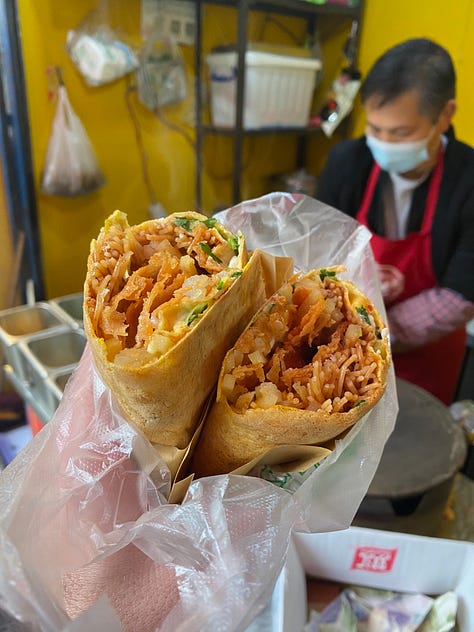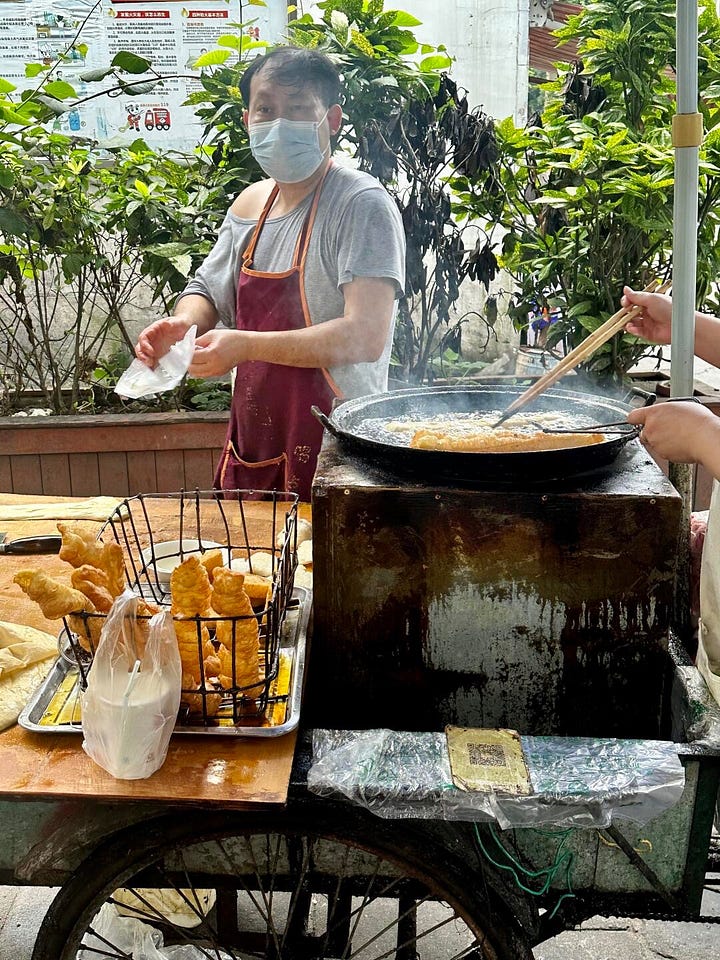Breakfast Bing
"Rolled Pancakes" (卷饼) that're actually quite convenient to the western kitchen.
If there’s one thing that I — and most foreigners in China, it seems — love, it’s some kind of bing in the morning.
There’s a lot of great breakfasts that can be had in China, of course. Doesn’t matter the city, you’re usually not overly far away from some sort of breakfast snack stall. In urban China, breakfast is something that’s often grabbed on the go — whether it’s Guangdong’s Cheongfun rice noodle rolls, Sticky rice Fantuan in Shanghai, or various forms of Baozi and Mantou that can be found stretching from the very north of the country to the far south.
But it’s various sorts of bing that personally get my blood moving. What can I say… I’m just a sucker for a burrito like object:



I know that I’m not alone in this obsession: among expats, exchange students, and travelers… consistently one of the most beloved dishes in China is the Jianbing Guozi — a mungbean flour bing originally from Tianjin, that can be found dotted outside college campuses across the country.
The problem with Jianbing Guozi
Now, I love Jianbing Guozi, don’t get me wrong. We covered true-blue street food style Jianbing on this channel before — we love it so much that we’ve even covered it with Taco Bell fillings.
But whipping out Jianbing like the vendors requires (1) some specialty equipment — at the very least, crepe making tools and (2) mungbean flour (not starch), an ingredient that can often be somewhat difficult to find outside of China. Not to mention that the thing also takes a bit of technique, so there’s a small learning curve to getting the dish right.
It’s a common issue with many much-beloved Chinese breakfasts. Because a lot of these dishes are things that’re eaten outside, they can often be sneaky difficult. For example, one of the most iconic breakfast pairings in China is soymilk with youtiao:


Soymilk is time consuming to make at home (though the truly devoted can spring for a soymilk machine). Youtiao isn’t an overly difficult dough, but most homecooks aren’t exactly breaking out the deep frying oil at 7am on a Tuesday either. Jianbing is involved, Cheongfun is involved, and I’m still not even sure how to tackle those Yunnanese Erkuai (above, middle).
It’s just… a different breakfast culture. The suburban nature of the North American development model means that it’s often inconvenient or cost-prohibitive for most people to eat breakfast on the go… so much like rural China, people make do at home.
And so, when English-language creators online cover something like a Jianbing, often they seem to take shortcuts to make it ‘fit’ more into people’s everyday lives in the west. I used to get angsty about this fact when I was younger, but the years have calmed me down. After all, not everyone is necessarily looking for the maximally culturally accurate breakfast Jianbing — the vast majority of normal people are probably perfectly happy with some sort of delicious jianbing-like-object.
But there might just be a different angle we could take.
Enter… Juanbing
This dish seems to go by a few different names around the country. Sometimes it’s called ‘Juanbing’ (rolled pancakes), sometimes ‘Danbing’ (egg pancakes), and sometimes ‘Jidan Juanbing’ (Egg rolled pancakes)1.
The pancake itself may look similar to a Jianbing, and it’s also a rather common sight at breakfast stands. But for the aspiring bing-making home cook, it’s got a number of advantages.
First, the batter is all normal wheat flour. So… no need to go and track down mungbean flour from specialty grocers. All of the ingredients to make the thing are western supermarket available.
Second, the gluten’s developed in this batter, making for a rather soft, chewy, and extensible pancake. This may not seem like an obvious advantage at first blush, but it has the advantage of allowing the pancake to keep. Think, say, a Japanese milk bread versus a traditional crusty Western-style loaf: the former stays chewy for days, while with the latter you might want to start toasting the thing on day two. Similarly, Jianbings start to degrade hours after to you get the thing… but with these, you can even make them the night before and keep them in the fridge the next morning.
So we’ll divide this post into a couple parts. First, we’ll cover how to make the bing – with instructions on how to keep it overnight if you so choose. Second, we’ll show you two possible fillings for this: (1) my personal favorite potato sliver filling, followed by (2) a very Jianbing-esque smorgasboard of fillings that can be found around the Yangtze river delta.
To make the batter.
In a bowl with
200g AP Flour
½ tsp salt
¼ tsp Chinese five spice powder, optional but recommended
drizzle
220 grams water
bit by bit, until you arrive at a soft dough. Patiently stir and fold the dough in one direction only to develop the gluten of the dough. Refer to 3:11 in the accompanying video for a visual. Once smooth (~10 minutes of stirring), drizzle
another 220 grams water
bit by bit, stirring and folding in the same direction. Rest for 30 minutes.
If you are holding the pancakes for the next morning:
To make the pancake we will use a non-stick skillet. Ours was 28cm in diameter for reference. Over a medium flame, ladle in ~6 tbsp batter and swirl to spread evenly.
Cover the skillet. Observe the condensation on the lid — uncovering and jiggling off any excess water drops that appear to be forming (you will likely need to do this once at around the 60-90 second mark). Once the pancake forms, ~2 minutes, flip. Cover, and cook for another 90 seconds on the other side.
Reserve the pancakes in the fridge.
The next morning, reheat or prepare any fillings you want. Also, beat
4 eggs
thoroughly in a bowl, until no stray strands of egg white remain.
To a skillet, add a pancake and allow ~30 seconds over a medium flame to warm up. Add three tablespoons of whisked egg, spreading it as you might tomato sauce on a pizza. Cover, and allow the egg to set, ~30 seconds.
Flip, cover, and shut off the flame. Allow to sit for another ~30 seconds to allow the residual heat further cook the egg.
Work through your pancakes. Once finished, place on a cutting board or work surface and wrap with your desired fillings.
If you eating the pancakes immediately
In a bowl, beat
4 eggs
thoroughly, until no stray strands of egg white remain.
To make the pancake we will use a non-stick skillet. Ours was 28cm in diameter for reference. Over a medium flame, ladle in ~6 tbsp batter and swirl to spread evenly.
Cover the skillet. Observe the condensation on the lid — uncovering and jiggling off any excess water drops that appear to be forming (you will likely need to do this once at around the 60-90 second mark). Once the pancake forms, ~2 minutes, flip.
Add three tablespoons of whisked egg, spreading it as you might tomato sauce on a pizza. Cover, and allow the egg to set, ~30 seconds.
Flip, cover, and shut off the flame. Allow to sit for another ~30 seconds to allow the residual heat further cook the egg.
Work through your pancakes. Once finished, place on a cutting board or work surface and wrap with your desired fillings.
Filling Option #1: Spicy Shredded Potato Slivers
Peel
500g potato
and slice it into thin slivers. Thoroughly wash to get off the surface starch, and transfer to a strainer. Blanch the potato for 60 seconds, then strain and shock with cool running water to stop the cooking process. Thoroughly dry2.
To stir fry, swirl
~2 tbsp oil
into a hot wok and over a medium low flame fry
2 cloves garlic, minced
until fragrant, ~30 seconds. Then up the flame to high and add in
2-3 spicy dried chilis, snipped into ~1cm sections
Once fragrant, swirl in
½ tbsp Shaoxing wine
over the spatula and around the side of the wok. Mix, then add in the potato slivers. Stir fry on high for ~30 seconds, then swirl in
1 tbsp soy sauce
and mix and stir fry for ~60 seconds. Season with
½ tsp salt
⅛ tsp MSG
¹⁄₁₆ tsp white pepper
and mix well. If you happen to have some on hand, also drizzle in
1 tbsp red chili oil, optional
The filling can be made in advance and reheated before making the pancake.
Filling Option #2: Jianbing-esque Fillings
You can find these fillings in pockets around the Yangtze River delta. Ultimately, most of these are optional — the sole critical bit is the ‘tianjiang’, i.e. the sauce that’s traditionally smothered over these sorts of bings. Besides this, I would personally recommend some kind of crunchy filling, even if it’s just a bit of Zhacai, or some sort of fusion-y concoction like tortilla chips.
To make the tianjiang, first prepare a slurry of
½ starch, preferably potato starch
1 tsp water
and set aside.
Then, in a saucepan, swirl in
1 tsp oil
and add in
1 tbsp hoisin sauce (海鲜酱)
1 tbsp sweet bean paste (甜面酱)
and fry until fragrant, ~1 minute. Add in
1 tbsp sugar
¼ tsp salt
¼ tsp MSG
and mix well. Then, pour in
¼ cup water
and thoroughly mix, until there are no clumps remaining. Drizzle in the slurry to thicken, then reserve.
When wrapping the bing, brush on a half tablespoon of the sauce. All the other fillings are up to you, but we added
1 tsp chili crisp
roughly shredded lettuce
a quarter of a youtiao
half a junky Chinese hotdog (spam might also be nice)
a good sprinkle of Zhacai
The actual pancake style comes from the north, where the categorization is much clearer: it is called mianhubing (面糊饼), or a ‘batter bing’.
If on a weak stove, you may want to dry in a salad spinner.




feel like jidan guanbing (鸡蛋灌饼) should get an honorable mention in this post.
for those who cant be bothered to do the guanbing from the ground up, an easier alternative is to buy frozen Indian Roti bread (印度飞饼). heat them with a nonstick pan, then pour battered egg inside to make a guanbing.
also, def worth it to get a soymilk machine.
Thanks for this! I loved jianbing when I lived in China but I can't find them here in the US. I will try this out as a substitute. I have managed a decent jianbing when I go out and get mung bean flour, but I use those wonton strips sold as salad toppings for the crunchy bit!